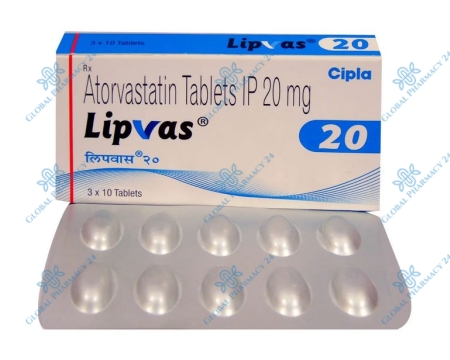| Characteristic | Detail |
|---|---|
| Active Ingredient | Simvastatin |
| Dosage Forms | Tablets (10mg, 20mg, 40mg, 80mg) |
| Indications | Hyperlipidemia, Hypercholesterolemia, Prevention of Cardiovascular Diseases |
| Duration of Effect | 24 hours |
| Common Side Effects | Headache, Muscle pain, Abdominal pain, Nausea |
Lipvas Overview: Breaking Down Its Components
Lipvas, a widely prescribed lipid-lowering agent, primarily contains Simvastatin as its active ingredient. This medication is designed to manage elevated cholesterol levels and reduce the risk of cardiovascular diseases. Its effectiveness is rooted in its ability to interfere with lipid synthesis pathways, thereby reducing harmful cholesterol levels in the blood.
Understanding the components and mechanism of Lipvas is crucial for both healthcare providers and patients. It offers a strategic approach to managing hyperlipidemia by targeting the foundational biochemical processes responsible for cholesterol accumulation. This comprehensive analysis sheds light on the drug's potency and its pivotal role in preventive healthcare.
What is Lipvas?
Lipvas is a statin medication used to control high cholesterol and triglyceride levels in the blood. It is particularly effective in preventing cardiovascular diseases, making it a cornerstone in the management of hyperlipidemia.
Lipvas' primary active ingredient: Simvastatin
The role of Simvastatin as a prodrug
Simvastatin serves as a prodrug, meaning it is activated in the body through metabolic processes. This activation inhibits a key enzyme, HMG-CoA reductase, which is essential for cholesterol production in the liver.
Lipvas' Mechanism of Action
The efficacy of Lipvas stems from its mechanism of action, targeting the HMG-CoA reductase pathway. This blockade significantly reduces the liver's cholesterol synthesis, thereby lowering blood cholesterol levels.
Inhibition of HMG-CoA reductase
The effect of this inhibition on cholesterol synthesis
By inhibiting HMG-CoA reductase, Lipvas effectively reduces the synthesis of cholesterol. This leads to a decrease in the overall levels of low-density lipoprotein (LDL) cholesterol, known as "bad" cholesterol.
Role in lipid reduction
Lipvas' effect on arteriosclerosis progression
Lipvas slows the progression of arteriosclerosis by lowering lipid levels, thus reducing the risk of developing heart disease and stroke.
Inhibition of exogenous cholesterol absorption
This medication also plays a role in inhibiting the absorption of cholesterol from the diet, further contributing to its lipid-lowering effects.
Potential Risks and Precautions with Lipvas Use
While Lipvas is effective in managing cholesterol levels, it is not without risks. Patients should be aware of potential side effects and the importance of adhering to their healthcare provider's guidelines.
Understanding the contraindications, drug interactions, and possible adverse effects is essential for safe and effective use. This knowledge empowers patients to make informed decisions about their healthcare regimen.
Contraindications and interactions
It is critical to consider the contraindications and potential drug-drug interactions when prescribing Lipvas to ensure patient safety and medication efficacy.
Lipvas contraindications
Drug-drug interactions
Overlapping contraindications
Lipvas adverse effects
Understanding the spectrum of Lipvas' side effects, from minor to major, is crucial for monitoring patient health throughout treatment.
Major side effects
Minor side effects
Comparison of Lipvas with other Lipid-Lowering Agents
The landscape of lipid-lowering therapy is diverse, with several options available. Comparing Lipvas to other statins and lipid-lowering agents can highlight its unique benefits and potential drawbacks.
This comparison allows healthcare providers to tailor therapy to individual patient needs, optimizing treatment outcomes.
FAQs Lipvas
What is Lipvas used for?
Lipvas is used to lower cholesterol levels in the blood. It belongs to a group of medications called statins, which work by reducing the amount of cholesterol produced by the liver.
How should I take Lipvas?
Lipvas should be taken exactly as prescribed by your doctor. It is usually taken once daily, with or without food. It is important to take Lipvas regularly to get the most benefit from it.
What are the possible side effects of Lipvas?
Some common side effects of Lipvas include headache, muscle aches, joint pain, and stomach pain. In rare cases, Lipvas can cause more serious side effects such as liver problems or muscle damage. If you experience any unusual symptoms while taking Lipvas, contact your doctor immediately.
Can I drink alcohol while taking Lipvas?
It is generally safe to drink alcohol in moderation while taking Lipvas. However, alcohol can increase the risk of liver problems, which can be a side effect of Lipvas. It is important to talk to your doctor about your alcohol consumption while taking Lipvas.





























